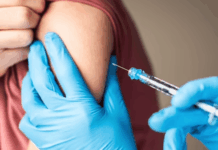
By Dr. Joseph Mercola,
Sexually transmitted diseases (STDs) continue to rise steeply in the U.S., and 2017 marked the fourth year in a row that this has been the case.
In fact, the number of STDs in the U.S. in 2017 surpassed the previous record set in 2016 by more than 200,000 cases, such that close to 2.3 million cases of chlamydia, gonorrhea and syphilis were diagnosed, the latest data from the U.S. Centers for Disease Control and Prevention (CDC) showed.1
Dr. Jonathan Mermin, director of the CDC’s National Center for HIV/AIDS, Viral Hepatitis, STD and TB Prevention, noted that “we are sliding backward,” as cases of STDs in the U.S. were in decline until the 1970s, at which point the trend reversed.2 “It is evident the systems that identify, treat and ultimately prevent STDs are strained to near-breaking point,” he said.3
It’s especially curious that STD rates are rising, as separate research suggests Americans are having less sex overall.4 A study in the Archives of Sexual Behavior, published in November 2017, suggested American adults had sex about nine fewer times per year in the early 2010s compared to the late 1990s.5
If this trend has continued, then what’s behind the rising rates of STDs? Likely, according to Gail Bolan, director of the CDC’s Division of STD Prevention, a rise in riskier sex practices, like not using condoms, along with high-risk sex associated with opioid use and addiction.6
Others suggest lack of funding for federal STD prevention programs and STD clinics is partly to blame, as people may be less likely to seek STD screening and treatment in a private setting (their physician’s office).7 Whatever the cause, what’s clear is that multiple populations may be threatened by these rising infection rates, especially as more cases turn out to be untreatable due to drug-resistance.
Gonorrhea, Syphilis and Chlamydia Increase Sharply
From 2013 to 2017, the three common STDs that follow showed striking increases:
Gonorrhea:
Cases increased 67 percent during the study period, rising to 555,608 cases in 2017. Diagnoses among men nearly doubled, although cases among women are also increasing. Gonorrhea often causes no symptoms, but in men it may lead to a burning sensation when urinating, discharge (white, yellow or green) from the penis or painful or swollen testicles. Rarely, it may lead to infertility.
In women, gonorrhea may cause vaginal bleeding or discharge or painful urination, but often causes no symptoms at all. Left untreated, the infection can lead to pelvic inflammatory disease (PID), which can cause infertility, ectopic pregnancy and pelvic or abdominal pain.
Untreated gonorrhea can also increase your risk of HIV infection.8 In pregnant women, gonorrhea can be transmitted to their baby during delivery, leading to blindness, joint infection or a life-threatening blood infection in the baby.9 Rectal infections with gonorrhea may lead to anal discharge, itching, soreness and bleeding or painful bowel movements.
Syphilis:
Cases increased 76 percent from 2013 to 2017, with men who have sex with men making up nearly 70 percent of the cases in which the gender of the sex partner was known. These numbers account for both primary and secondary syphilis cases, which are the most infectious stages of the disease.
During primary syphilis, a painless sore (or sores) occur at the site of infection, typically on the genitals, around the anus or in the mouth. In the secondary phase, symptoms including rash, swollen lymph nodes and fever, but may be so mild that you don’t notice.
The initial sore will typically disappear in three to six weeks, and the infection can enter a latent stage for years without any symptoms.
Syphilis can also be transmitted to a baby during pregnancy. In rare cases, if left untreated, 10 to 30 years after the initial infection, syphilis can enter the tertiary stage that causes internal organ damage and possibly death. It can also lead to neurosyphilis or ocular syphilis, in which your brain, nervous system and eyes can be damaged.10
Chlamydia:
Chlamydia was the most common STD reported to the CDC, with more than 1.7 million cases diagnosed in 2017. Forty-five percent of cases occurred among 15- to 24-year-old females. Chlamydia often causes no symptoms. When it does, it may lead to abnormal vaginal discharge or burning during urination in women or, for men, discharge from the penis, burning during urination and painful or swollen testicles.
If left untreated, chlamydia can lead to PID, causing damage to a woman’s reproductive system leading to infertility or ectopic pregnancy. It can also be transmitted to your baby during childbirth. Untreated chlamydia may also increase your risk of HIV.
As for whether or not the trend will continue, Dr. Edward Hook, endowed professor of infectious disease translational research at the University of Alabama at Birmingham’s School of Medicine, told CNN, “It’s important to remember that while these are preliminary data, and the data are eight months out of date, there’s absolutely no reason to think that the increases that are being described by the CDC haven’t continued into 2018.”11
Drug-Resistant STDs are Rising
For now, chlamydia, gonorrhea and syphilis can be treated with antibiotics, provided a person realizes they’re infected and seeks treatment. However, this may not be the case for long, as drug-resistant infections are becoming more common. This is particularly true with gonorrhea, which has become resistant to virtually every class of antibiotics available, except for ceftriaxone.
The CDC recommends a dual therapy approach consisting of an injection of ceftriaxone followed by an oral dose of azithromycin to treat gonorrhea, which is intended to keep ceftriaxone working against the infection as long as possible.
However, the CDC now found that gonorrhea may be developing resistance to azithromycin. Azithromycin-resistant gonorrhea increased from 1 percent in 2013 to more than 4 percent in 2017. According to the report:12
“The finding adds concerns that azithromycin-resistant genes in some gonorrhea could crossover into strains of gonorrhea with reduced susceptibility to ceftriaxone — and that a strain of gonorrhea may someday surface that does not respond to ceftriaxone.
‘We expect gonorrhea will eventually wear down our last highly effective antibiotic, and additional treatment options are urgently needed,’ said Gail Bolan, M.D., director of CDC’s Division of STD Prevention. ‘We can’t let our defenses down — we must continue reinforcing efforts to rapidly detect and prevent resistance as long as possible.’”
Syphilis is also resistant to azithromycin, the second drug of choice for this infection, and research looking at syphilis samples from the U.S., South America, Europe, Africa and Australasia found both of the two main strains of syphilis have developed antibiotic resistance.
Super Gonorrhea Already Exists Worldwide
It’s likely only a matter of time before “super gonorrhea” appears in the U.S. In the U.K., for instance, the first case of gonorrhea that’s resistant to both ceftriaxone and azithromycin has already been reported.13 The man was diagnosed in early 2018, and it’s believed he contracted the infection via sexual activity with a person in Southeast Asia about a month prior.
Dr. Gwenda Hughes, consultant scientist and head of the sexually transmitted infection section at Public Health England (PHE), said in a statement, “[The infection] … is very resistant to the recommended first-line treatment … This is the first time a case has displayed such high-level resistance to both of these drugs and to most other commonly used antibiotics.”14
The patient was treated with an intravenous antibiotic called ertapenem, which is related to ceftriaxone.15 Further, in a study of 77 countries, WHO reported widespread resistance to ciprofloxacin, with 97 percent of countries reporting drug-resistant strains, and increasing resistance to azithromycin, with 81 percent of countries reporting resistance.
Overall, 66 percent of countries had seen gonorrhea strains resistant to extended-spectrum cephalosporins (ESCs), oral cefixime or injectable ceftriaxone, the current last-resort treatments.
According to WHO, “Currently, in most countries, ESCs are the only single antibiotic that remain effective for treating gonorrhea. But resistance to cefixime — and more rarely to ceftriaxone — has now been reported in more than 50 countries.”16
Are Dating Apps a Contributor to Rising STD Rates?
Most talks of rising STD rates focus the blame on political issues (lack of funding), rising addiction rates (including to opioids) or less use of condoms, perhaps because fears of HIV/AIDs have dwindled in recent years. However, popular dating apps could also be playing a role, according to the British Association for Sexual Health and HIV, by encouraging people to change partners frequently.17
In one area in South Wales, cases of syphilis increased by fivefold over a four-month period, and the health board believed it could be due to more people using dating apps to meet up for unprotected sex. Because users often delete their partners’ profiles after meeting them, it’s also difficult to provide warnings if an STD is later diagnosed.18
Ultimately, it’s not the apps that are the problem, but the unprotected sex that may result from the meetings. If you use such apps responsibly and use condoms consistently with any new or casual partners, it can reduce your risk of STDs considerably, although condom use does not protect against every STD.
Being in a mutually monogamous relationship with a partner who does not have an STD will reduce your risk further, as will getting tested (both partners) prior to sexual intercourse with a new partner. Getting screened regularly is also important so you can get treatment promptly if an STD is diagnosed.
A Comprehensive Plan for Warding Off Antibiotic-Resistant Disease
Practicing safe sex practices is essential for avoiding STDs, but you can also bolster your immune defenses using the tips below so that, in the event you’re exposed to an antibiotic-resistant microbe of any kind, your body has a better chance of fighting it off:
Avoid foods that tax your immune system such as synthetic trans fats, fried foods, processed foods, sugar and grains; reduce net carbohydrates (sugar, grains, fructose) and protein, replacing them with high-quality fats.
Most of your diet should be fresh, whole foods, like organic vegetables and grass fed meats and dairy, and beneficial fats, such as raw, grass fed butter and fermented dairy from grass-pastured animals, cheese, egg yolks and avocados. A great portion of your immune system resides in your GI tract, which depends on a healthy, balanced gut flora.
One of the best ways to support this is by incorporating naturally fermented foods into your diet, You can take a high-quality probiotic supplement, but the actual fermented foods offer the greatest benefit. You may also want to consider a ketogenic diet.
Exercise improves the circulation of immune cells in your blood. The better these cells circulate, the more efficient your immune system is at locating and eliminating pathogens in your body.
Make sure your fitness plan incorporates weight training, high-intensity interval exercises, stretching and core work, and get plenty of nonexercise movement daily (strive to sit for fewer than three hours a day).
Get plenty of restorative sleep:
Sleep deprivation has the same effect on your immune system as physical stress or disease,19 which is why you may feel ill after a sleepless night.
Have good stress-busting outlets:
High levels of stress hormones can diminish your immunity, so be sure you’re implementing some sort of stress management. Meditation, prayer, yoga, and the Emotional Freedom Techniques (EFT) are all excellent strategies for managing stress. (See: 10 Fun Ways To Reduce Your Cortisol Levels.)
Optimize your vitamin D levels:
Studies have shown that inadequate vitamin D can increase your risk for MRSA and other infections. Your best source of vitamin D is through exposing your skin to the sun. Monitor your vitamin D levels to confirm they’re in the therapeutic range, 60 to 80 ng/ml.
If you can’t get regular sunlight exposure, consider taking an oral vitamin D3 supplement. Just keep in mind that if you take high-dose vitamin D, you may also need to increase your intake of calcium, magnesium and vitamin K2 for proper balance.
- 1, 3, 12 U.S. CDC August 28, 2018
- 2 Centers for Disease Control and Prevention, Reported STDs in the United States, 2016
- 4, 6 The Atlantic August 29, 2018
- 5 Archives of Sexual Behavior November 2017, Volume 46, Issue 8, pp 2389-2401
- 7 Time August 29, 2018
- 8 U.S. CDC, Gonorrhea
- 9 U.S. CDC, Gonorrhea Fact Sheet
- 10 U.S. CDC, Syphilis
- 11 CNN August 28, 2018
- 13 Public Health England March 29, 2018
- 14, 15 Public Health England March 28, 2018
- 16 World Health Organization July 7, 2017
- 17 BBC Newsbeat November 1, 2015
- 18 NY Post August 27, 2018
- 19 Sleep. 2012 Jul 1; 35(7): 933–94
Disclaimer: We at Prepare for Change (PFC) bring you information that is not offered by the mainstream news, and therefore may seem controversial. The opinions, views, statements, and/or information we present are not necessarily promoted, endorsed, espoused, or agreed to by Prepare for Change, its leadership Council, members, those who work with PFC, or those who read its content. However, they are hopefully provocative. Please use discernment! Use logical thinking, your own intuition and your own connection with Source, Spirit and Natural Laws to help you determine what is true and what is not. By sharing information and seeding dialogue, it is our goal to raise consciousness and awareness of higher truths to free us from enslavement of the matrix in this material realm.
 EN
EN FR
FR


























